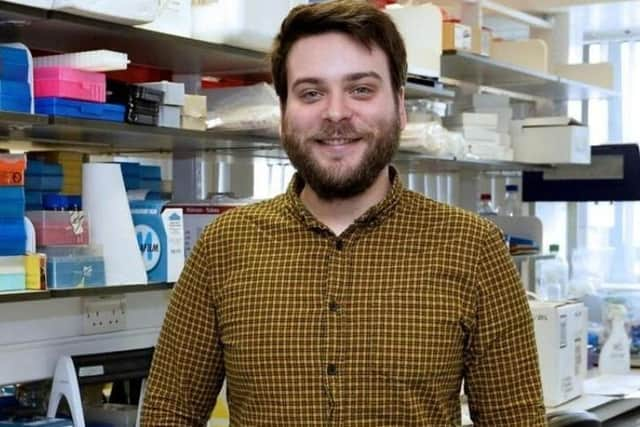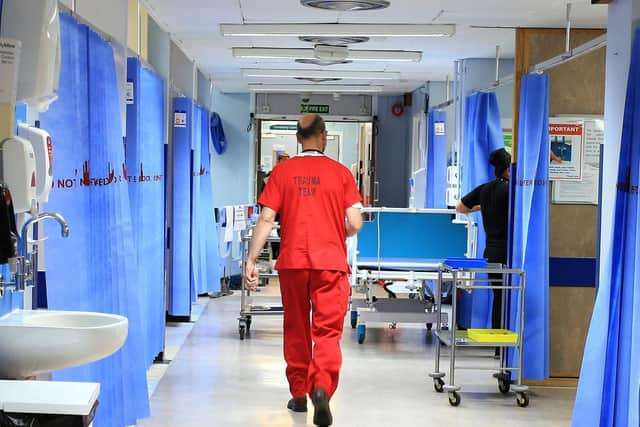NI virologist warns COVID-19 is ‘airborne’ and social distancing is going to be with us for quite some time to come’
and live on Freeview channel 276
Dr Connor Bamford, is an expert in respiratory viruses and immunity to them and is working on a vital UK-funded Covid-19 project to find drugs that will treat patients and eradicate some of the symptoms of the potentially lethal illness which include high fever and damage to the lungs that can leave sufferers on ventilators in ICU, also reveals: “Lot’s of animals have them, birds, pigs, cows.
He explains that while Covid-19 is a new development we have in fact known about so-called coronaviruses for a very long-time. “There are lots of different corornaviruses,” explains Connor.
Advertisement
Hide AdAdvertisement
Hide Ad“Lot’s of animals have them, birds, pigs, cows. This is actually the seventh human coronavirus we have come across. There are four that cause the common cold, although in some people they will cause more serious disease, and mostly occur in the winter.
People don’t pay much attention to these very obscure viruses. Then there are three quite dangerous emerging coronaviruses.”
One is SARS COVI 2, which causes Covid-19, but then there is also the original SARS which emerged in 2002 when it was quite deadly and there is another one called MERS, which is Middle Eastern Respiratory Syndrome virus, which is found in camels in the Middle East that can travel from camels to humans and cause deadly disease. But we are concerned about these coronaviruses and of course at the moment particularly the one that causes Covid-19.
“The defining thing about a coronavirus is that when you look at them under a microscope they have this crown-like image that are caused by these viral proteins that look like spikes. Like the corona of a sun or a crown shape and they are quite complicated in the genes they have.
“They look distinctive to other viruses in this sense.”


Advertisement
Hide AdAdvertisement
Hide AdDr Bamford maintains that the chances of a second surge or spike in Covid-19 cases is very likely once the lockdown we are living under is eased.
“This virus was established in March in Northern Ireland and very quickly it began to spread and we brought lockdown in to flatten the peak. So we have now a pretty long plateau.
It is very likely that a surge could occur again as it did at the beginning of March when we first had evidence of transmission in the community.
This is only being kept at bay due to lockdown and social distancing. At the minute five to ten per cent of the Northern Ireland population have been infected,


Advertisement
Hide AdAdvertisement
Hide AdBut you have to remember that means there are 90 per cent who have not been infected who will be susceptible, who have no immunity to the virus. We could feasibly lift some aspects of the lockdown if however we continued to enforce some aspects of rigorous social distancing.
It would also be necessary for us to introduce other measures such as increased testing and contract tracing as well as isolating those who are infected. So we would need more surveillance and isolation of infected persons.
“The difficulty with Covid-19 is that because many carriers are asymptomatic they could be passing on the virus to others without realising and without adequate testing we have no way of knowing who needs to self-isolate.
“We have evidence that contact tracing for Ebola virus, for example, worked very well in Africa, because people could only pass on the virus when they were sick and that was evident from the symptoms they were displaying. The difference with Covid-19 is that it is much more insidious and asymptomatic people can be carriers.
Advertisement
Hide AdAdvertisement
Hide Ad“It is airborne. Contact tracing could work to a degree but there is no guarantee of total efficacy. We do have apps that might allow for some degree of tacing or monitoring, in theory that could work in terms of manual contract tracing, but it would still be difficult.”
The NHS CV19 app will enable the public to report their symptoms and order a swab test online if available. The NHS hopes it will be ready in two to three weeks, though the timetable for rollout is unclear.
Once someone installs the app, it will start logging the distance between the user’s phone and others nearby that also have the app installed, using Bluetooth Low Energy. This anonymous log of how close they are to others will be stored securely on their phone.
If they become unwell with symptoms of Covid-19, they can choose to let the app inform the NHS. That will trigger an anonymous alert to other app users with whom they spent time over the previous few days. Those users will get an alert telling them they have been close to someone with the virus. It may advise them to self-isolate.
Advertisement
Hide AdAdvertisement
Hide AdDoes Dr Bamford believe that our local government response was swift enough and proportionate in its response to the pandemic?
“It was a very difficult situation and nobody knew what to expect. But it was probably not the swiftest response, and speed trumps everything in this. We can look at other countries such as Portugal, Austria and Denmark that have never had proper outbreaks because they brought in lockdown very quickly. What happened here in the UK is that the virus had already spread throughout communities before the lockdown was announced, But lockdown has worked and we have saved lots of lives. But had we acted earlier, we could have saved yet more lives.”
Northern Ireland and Scotland have fared better in terms of infection rates during lockdown compared to other regions of the UK. “We have come out of this comparably well,” he adds.
What would Dr Bamford say to those who feel that lockdown is perhaps a disproportionate response and that while staving the spread of infection it is opening us up to a welter of other problematic issues such as an eviscerated economy and dwindling public mental health?
Advertisement
Hide AdAdvertisement
Hide Ad“The fact is that in Northern Ireland thousands of people are not sick now because of lockdown. Every single day of lockdown increases the number of lives saved. It’s all we’ve got, combined with social distancing, to fight back against this deadly disease.
“There is an argument that we could relieve some aspects of it but again we don’t really know how to do that. It would have to be done slowly and moderately and in line with other measures such as increased testing and tracing.”
What kind of time frame are we talking about in terms of how long lockdown may continue?
“The statistics we have are not completely accurate but they give us an important picture of what the level of infection is throughout the population. The stats show that there is plenty of infection out there, but the worrying thing is that we don’t really know where that is. We aren’t testing widely in the community as I would like to see. I think this will come into force eventually.
Advertisement
Hide AdAdvertisement
Hide Ad“Before ending lockdown we need to see the figures of deaths come down. I would like to see several days where nobody died of Covid-19 before we relaxed measures. Three weeks, perhaps into May, we could think about easing restrictions. What is happening in Northern Ireland is not on the same scale as on the UK mainlaind.
“I think in three weeks time we might be in a position to look at how we could ease lockdown but we would need to maintain social distancing, increase testing in the community and consider contact tracing. Rigorous social distancing will have to be in place and we will always have to be mindful that there is the possibility that we could face coming out of and then moving into a second lockdown depending on the rate of infection.”
How far down the line does Bamford think a Covid-19 vaccine might become available?
“We are trying to make one that is accessible for use across the world and there are trials going on but it is something that cannot be rushed and will take time and scientific expertise. It is difficult. We have an idea how this can work. It will be possibly really next year before a vaccine will be readily available and we will need to be patient. Until then even when lockdown is lifted social distancing measures are going to be part of our lives for the foreeable future. That is a difficult reality but one that will be necessary.”